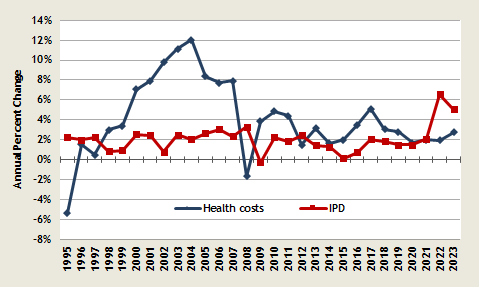Change in medical costs
| Year | Change |
|---|---|
| 2024 | 5.0% |
| 2023 | 2.7% |
| 2022 | 2.0% |
| 2021 | 2.0% |
| 2020 | 1.7% |
| 2019 | 2.8% |
| 2018 | 3.1% |
| 2017 | 5.1% |
| 2016 | 3.5% |
| 2015 | 2.0% |
| 2014 | 1.6% |
| 2013 | 3.1% |
| 2012 | 1.5% |
| 2011 | 4.4% |
| 2010 | 4.9% |
| 2009 | 3.9% |
| 2008 | -1.7% |
| 2007 | 7.9% |
| 2006 | 7.7% |
| 2005 | 8.4% |
| 2004 | 12.0% |
1995-2024

- Health care, including employee health insurance and medical assistance, is over 20% of the general fund budget.
- The size of the health care budget, combined with the rapid growth in per capita health care costs, make this a prime source of pressure on spending.
- Except for a brief period in the mid-1990s and during the recession in 2008 and during this recent COVID-19 pandemic period, health care costs have grown much faster than general inflation as measured by the Implicit Price Deflator (IPD) for personal consumption.
- Beginning in 2002, cost shifts from employers to employees resulted in much of the decrease in growth of employer medical costs.
- More recent employer cost control efforts have included generic drug preferences, care management incentives, high-deductible consumer-directed health plans, and health savings accounts (HSAs).
- In fiscal year 2024, health care costs for state and local employees grew more than twice as fast as the overall inflation reflected in the economy.This highlights that health care is a significant driver of rising expenses for state and local governments, outpacing the general price increases of goods and services.
Data Sources:
- Office of Financial Management
- U.S. Department of Labor, Bureau of Labor Statistics
- Bureau of Economic Analysis
E-mail: OFM.Forecasting@ofm.wa.gov
Last updated
Thursday, December 12, 2024


